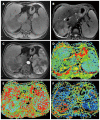Advanced imaging techniques in the therapeutic response of transarterial chemoembolization for hepatocellular carcinoma
- PMID: 27239110
- PMCID: PMC4873876
- DOI: 10.3748/wjg.v22.i20.4835
Advanced imaging techniques in the therapeutic response of transarterial chemoembolization for hepatocellular carcinoma
Abstract
Hepatocellular carcinoma (HCC) is one of the major causes of morbidity and mortality in patients with chronic liver disease. Transarterial chemoembolization (TACE) can significantly improve the survival rate of patients with HCC and is the first treatment choice for patients who are not suitable for surgical resections. The evaluation of the response to TACE treatment affects not only the assessment of the therapy efficacy but also the development of the next step in the treatment plan. The use of imaging to examine changes in tumor volume to assess the response of solid tumors to treatment has been controversial. In recent years, the emergence of new imaging technology has made it possible to observe the response of tumors to treatment prior to any morphological changes. In this article, the advances in studies reporting the use of computed tomography perfusion imaging, diffusion-weighted magnetic resonance imaging (MRI), intravoxel incoherent motion, diffusion kurtosis imaging, magnetic resonance spectroscopy, magnetic resonance perfusion-weighted imaging, blood oxygen level-dependent MRI, positron emission tomography (PET)/computed tomography and PET/MRI to assess the TACE treatment response are reviewed.
Keywords: Blood oxygen level-dependent; Chemoembolization; Computed tomography perfusion imaging; Diffusion kurtosis imaging; Diffusion-weighted imaging; Hepatocellular carcinoma; Intravoxel incoherent motion; Magnetic resonance perfusion-weighted imaging; Magnetic resonance spectroscopy.
Figures


Similar articles
-
Computed tomography perfusion in evaluating the therapeutic effect of transarterial chemoembolization for hepatocellular carcinoma.World J Gastroenterol. 2008 Oct 7;14(37):5738-43. doi: 10.3748/wjg.14.5738. World J Gastroenterol. 2008. PMID: 18837093 Free PMC article.
-
Computed tomographic perfusion with 160-mm coverage: comparative analysis of hepatocellular carcinoma treated by two transarterial chemoembolization courses relative to magnetic resonance imaging findings.Abdom Radiol (NY). 2019 Jan;44(1):85-94. doi: 10.1007/s00261-018-1714-x. Abdom Radiol (NY). 2019. PMID: 30054686
-
The Efficacy of Cone-Beam CT-Based Liver Perfusion Mapping to Predict Initial Response of Hepatocellular Carcinoma to Transarterial Chemoembolization.J Vasc Interv Radiol. 2019 Mar;30(3):358-369. doi: 10.1016/j.jvir.2018.10.002. J Vasc Interv Radiol. 2019. PMID: 30819478
-
PET/Computed Tomography in Evaluation of Transarterial Chemoembolization.PET Clin. 2015 Oct;10(4):507-17. doi: 10.1016/j.cpet.2015.05.006. Epub 2015 Jul 11. PET Clin. 2015. PMID: 26384597 Review.
-
Therapeutic response assessment of transcatheter arterial chemoembolization for hepatocellular carcinoma: ultrasonography, CT and MR imaging.Oncology. 2013;84 Suppl 1:58-63. doi: 10.1159/000345891. Epub 2013 Feb 20. Oncology. 2013. PMID: 23428860 Review.
Cited by
-
Evaluation of motion artifacts reduction software that compensate for respiratory movements in the craniocaudal direction during abdominal cone-beam computed tomography.Radiol Phys Technol. 2023 Jun;16(2):338-345. doi: 10.1007/s12194-023-00707-4. Epub 2023 Mar 7. Radiol Phys Technol. 2023. PMID: 36881329
-
Hepatocellular carcinoma: State of the art diagnostic imaging.World J Radiol. 2023 Mar 28;15(3):56-68. doi: 10.4329/wjr.v15.i3.56. World J Radiol. 2023. PMID: 37035828 Free PMC article. Review.
-
Is Adjuvant Cellular Immunotherapy Essential after TACE-Predominant Minimally-Invasive Treatment for Hepatocellular Carcinoma? A Systematic Meta-Analysis of Studies Including 1774 Patients.PLoS One. 2016 Dec 22;11(12):e0168798. doi: 10.1371/journal.pone.0168798. eCollection 2016. PLoS One. 2016. PMID: 28006010 Free PMC article.
-
Comprehensive Analysis of Factors Affecting Clinical Response and Short-Term Survival to Drug-Eluting Bead Transarterial Chemoembolization for Treatment in Patients With Liver Cancer.Technol Cancer Res Treat. 2018 Jan 1;17:1533033818759878. doi: 10.1177/1533033818759878. Technol Cancer Res Treat. 2018. PMID: 29739274 Free PMC article. Clinical Trial.
-
Progress of intravoxel incoherent motion diffusion-weighted imaging in liver diseases.World J Clin Cases. 2020 Aug 6;8(15):3164-3176. doi: 10.12998/wjcc.v8.i15.3164. World J Clin Cases. 2020. PMID: 32874971 Free PMC article. Review.
References
-
- Lo CM, Ngan H, Tso WK, Liu CL, Lam CM, Poon RT, Fan ST, Wong J. Randomized controlled trial of transarterial lipiodol chemoembolization for unresectable hepatocellular carcinoma. Hepatology. 2002;35:1164–1171. - PubMed
-
- Marelli L, Stigliano R, Triantos C, Senzolo M, Cholongitas E, Davies N, Tibballs J, Meyer T, Patch DW, Burroughs AK. Transarterial therapy for hepatocellular carcinoma: which technique is more effective? A systematic review of cohort and randomized studies. Cardiovasc Intervent Radiol. 2007;30:6–25. - PubMed
-
- Llovet JM, Real MI, Montaña X, Planas R, Coll S, Aponte J, Ayuso C, Sala M, Muchart J, Solà R, et al. Arterial embolisation or chemoembolisation versus symptomatic treatment in patients with unresectable hepatocellular carcinoma: a randomised controlled trial. Lancet. 2002;359:1734–1739. - PubMed
-
- European Association For The Study Of The Liver, European Organisation For Research And Treatment Of Cancer. EASL-EORTC clinical practice guidelines: management of hepatocellular carcinoma. J Hepatol. 2012;56:908–943. - PubMed
Publication types
MeSH terms
LinkOut - more resources
Full Text Sources
Other Literature Sources
Medical
Miscellaneous

